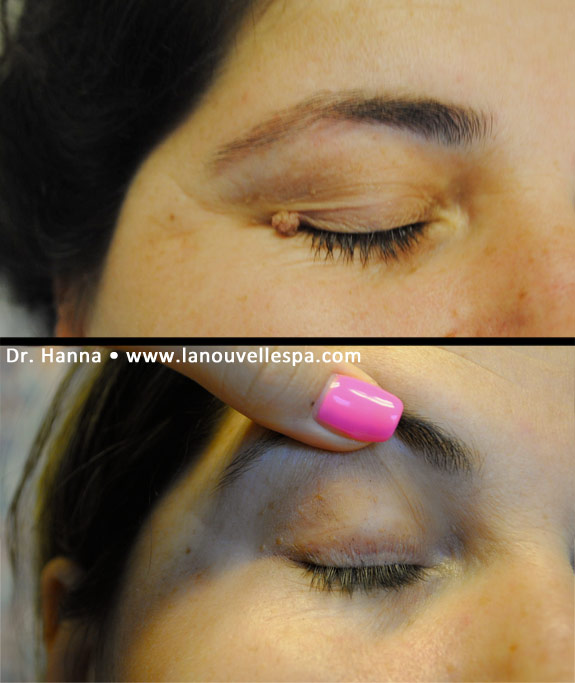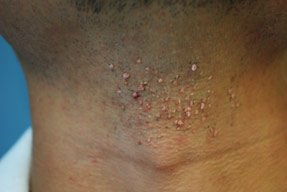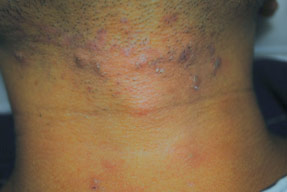We specialize in Mole Removal!
Treatment Options
In our office we use 3 procedures to remove moles or warts. The first two are surgical methods for removing moles – excision with stitches and excision with cauterization or using heat to destroy the mole. We also successfully use a Laser to remove moles. However, it is not the method of choice for treating deep moles because the light does not permeate deep enough. Dr. Hanna may choose excision with or without stitches. The method of removal is dependent upon the deepness of the mole and the cosmetic results you desire.
| Mole Removal - Before and After Images* |
| Before & After |
 |
| Below are the enlarged photos |
 |
*There's no guarantee of specific results. Results may vary from person to person
| Before and After Images* | |
Warts Before |
Warts next day After procedure |
 |
 |
*There's no guarantee of specific results. Results may vary from person to person
What is a mole?
While doctors utilize different terms to define a mole, many people describe a mole or nevi as any irregularity or dark spot on the skin. Birthmarks, hemangiomas (abnormal blood vessels and Keratoses (precancerous or benign spots) are not treated the same way as moles. Typically, some people are born with moles. They can also develop over time. Exposure to the sun appears to be a factor that stimulates the formation of an atypical or dysplastic mole. Dysplastic moles tend to be hereditary. Many families have a history of dysplastic moles. People with dysplastic moles are at a higher risk for developing melanoma, a malignant type of skin cancer.
Risks
• Risks vary depending on the area being treated and the method of removal.
• One of the most common difficulties after mole removal is a scar. Many people will attempt to remove moles for cosmetic reasons, not realizing that each and every removal may result in a scar. Dr. Hanna will give you an idea if you are going to have a scar, its type and location after mole removal before you make your decision about removal.
Mole Removal Preparation
• The area to be treated will be cleansed. Depending on Dr. Hanna's choice, this will be done either with alcohol, Betadine, or another suitable material.
• Then, the area will be numbed with anesthetic, such as lidocaine (Anestacon, Bactine, LidaMantle, Lidocaine Viscous, Lidoderm, Medi-Quik Spray, Xylocaine Jelly, Xylocaine Topical, Xylocaine Viscous, Zilactin-L). This will not usually take much time to accomplish. Usually Dr. Hanna prefers to wait after numbing to allow the blood flow to the area to diminish (sometimes up to 15 minutes).
• Depending on the size of mole and removal method, a drape may be placed over the area to be treated.
During the Procedure
• Mole Removal with simple cutting without stitches
• Dr. Hanna shaves the mole off flush or slightly below the level of skin.
• Then, either an electrical instrument will cauterize or burn the area or a solution will be placed on the area to stop any bleeding.
• After this, a topical antibiotic is placed on the wound.
• The wound is then covered with a bandage.
• Dr. Hanna will give you instructions on how to take care of your wound. You are usually able to leave shortly after.
• Mole Removal by cutting with stitches
• Moles removed by excision (cutting) with stitches are usually darker in color or flat moles, or both.
• Dr. Hanna will map out the mole and then sterilize or clean the area and numbs it.
• Then, he will cut the mole and a border surrounding the mole. The border size depends on Dr. Hanna's concern about the possible chances of pre-cancer or cancer for the mole being removed.
• Depending on the depth, stitches are placed either deep (these are absorbed by the body and do not have to be removed) or on the upper surface of the skin (these don't absorb and will be removed later).
After the Procedure / Home Care
• After the procedure, you need to keep a layer of antibiotic salve and a bandage on the wound. Use an antibiotic ointment that does not include neomycin (Medi-Quik, Neosporin, triple antibiotic). Many people are allergic to neomycin and may develop a rash at the site. Polysporin is a brand that does not contain neomycin.
• Clean the wound once or twice daily with either water or diluted hydrogen peroxide.
• After cleaning the wound, apply the antibiotic salve and bandage.
• These steps are repeated until the wound is healed.
Misconceptions about healing
• Some people think that wounds need to be open to the air and that this helps healing. Several studies have disproved this and found significantly quicker healing with bandages and antibiotic salve.
• Similarly, vitamin E has been found to slow healing rather than accelerate it, and scars were shown to be worse with vitamin E placed directly on wounds than without it.
• Neosporin is something that is commonly used over wounds, but this can often cause an allergic reaction. For this reason, we recommend the brand name Polysporin to our patients. If patients are allergic to this, studies have shown that simple Vaseline Petroleum Jelly is adequate in most cases.
If you'd like to view before and after pictures, please visit our Mole Removal Library. Please also check out testimonials from our happy clients.
